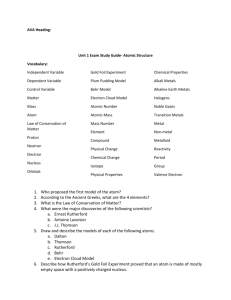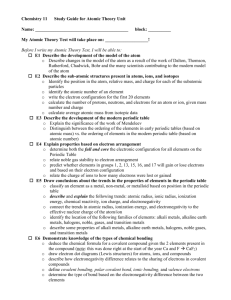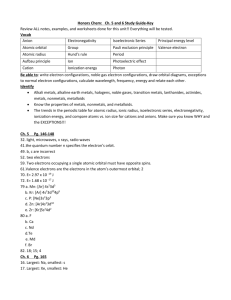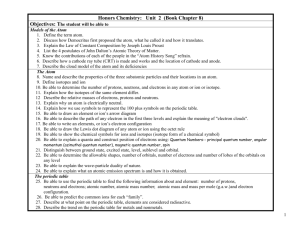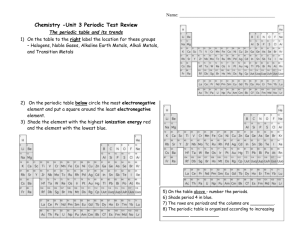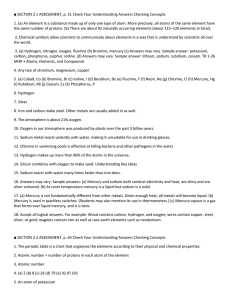Chemistry Atom Test: Electron Configuration & Nuclear Reactions
advertisement
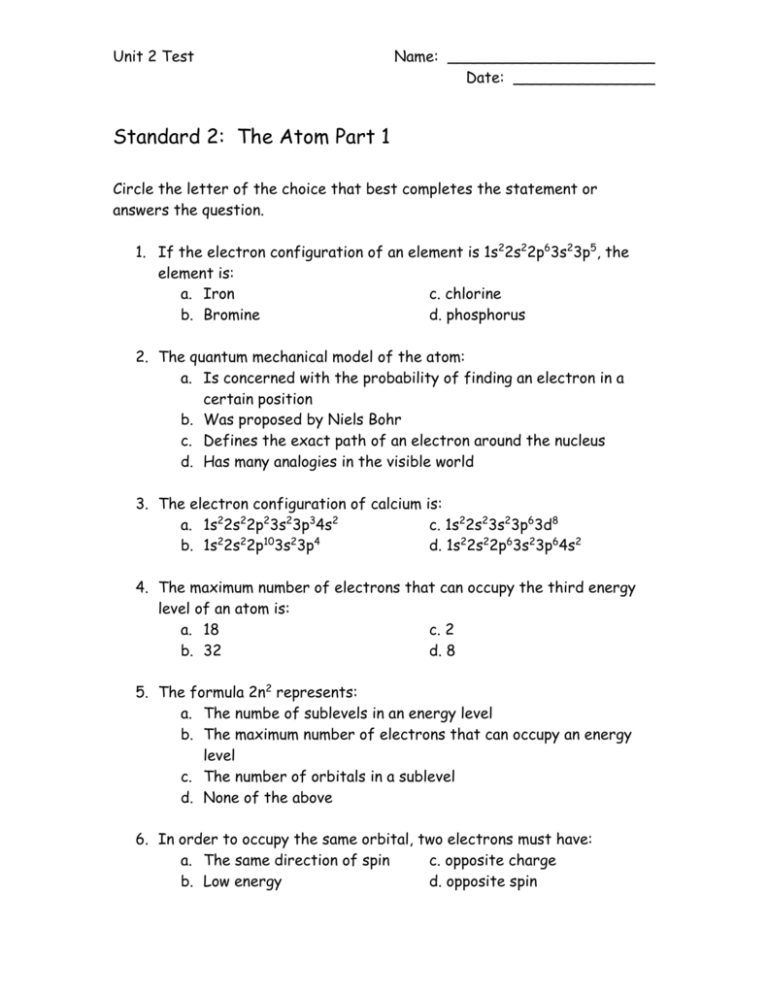
Unit 2 Test Name: ______________________ Date: _______________ Standard 2: The Atom Part 1 Circle the letter of the choice that best completes the statement or answers the question. 1. If the electron configuration of an element is 1s22s22p63s23p5, the element is: a. Iron c. chlorine b. Bromine d. phosphorus 2. The quantum mechanical model of the atom: a. Is concerned with the probability of finding an electron in a certain position b. Was proposed by Niels Bohr c. Defines the exact path of an electron around the nucleus d. Has many analogies in the visible world 3. The electron configuration of calcium is: a. 1s22s22p23s23p34s2 c. 1s22s23s23p63d8 b. 1s22s22p103s23p4 d. 1s22s22p63s23p64s2 4. The maximum number of electrons that can occupy the third energy level of an atom is: a. 18 c. 2 b. 32 d. 8 5. The formula 2n2 represents: a. The numbe of sublevels in an energy level b. The maximum number of electrons that can occupy an energy level c. The number of orbitals in a sublevel d. None of the above 6. In order to occupy the same orbital, two electrons must have: a. The same direction of spin c. opposite charge b. Low energy d. opposite spin Unit 2 Test Name: ______________________ Date: _______________ 7. (Omit CP) As the frequency of light increases, the wavelength: a. Increases c. decreases b. Remains the same d. approaches the speed of light 8. In the periodic table, there is a periodic pattern in the physical and chemical properties of elements when they are arranged in order of: a. Increasing atomic mass c. increasing atomic radius b. Increasing electronegativity d. increasing atomic number 9. Which orbital corresponds to the transition metals on the periodic table? a. s c. d b. p d. f 10. The representative elements are usually called: a. Inner transition metals c. Group B elements b. Transition metals d. Group A elements 11. The subatomic particle that plays the biggest role in determining the physical and chemical properties of an element is the: a. Proton c. electron b. Neutron d. photon 12. Which of the following atoms would you expect to have the largest atomic radius? a. I c. Ca b. K d. Rb 13. Electronegativity: a. Generally decreases from left to right across a period b. Is the energy change that accompanies the loss of an electron from a gaseous atom c. Generally decreases as you move down a group d. Is generally higher for metals than for nonmetals Unit 2 Test Name: ______________________ Date: _______________ 14. Which type of ionizing radiation can be blocked by clothing? a. Alpha particle c. X-radiation b. Gamma radiation d. beta particle 15. If an isotope undergoes beta emission: a. The mass number changes b. The atomic number changes c. The atomic number remains the same d. The number of neutrons remains the same 16. In nuclear fission: a. Certain atoms break into fragments when struck by neutrons b. A chain reaction cannot occur c. Energy is absorbed d. All of these 17. Nuclear fusion: a. Occurs when large nuclei fuse together b. Takes place in the sun c. Generally produces hydrogen nuclei d. All of these Identify the elements that have the following electron configurations: 18. 1s22s22p63s23p1 __________________ 19. 1s22s22p63s23p64s23d104p6 __________________ 20. 1s22s22p63s23p64s23d7 __________________ Consider the elements neon, bromine, and phosphorus. Which has: 21. three electrons in its 3p sublevel? __________________ 22. its highest energy level completely filled? 23. the highest occupied energy level? _____________ __________________ Unit 2 Test Name: ______________________ Date: _______________ Write the electron-dot structure for the following elements: 24. He ______________________ 25. K ______________________ 26. Al ______________________ 27. O ______________________ Tell which element in each of the following pairs has the higher electronegativity: 28. Na, Mg _______________________ 29. Rb, I _______________________ 30. Cl, Br _______________________ 31. (Honors only!) What is the frequency of radiation whose wavelength is 6.25 x 10-5 cm? c = 3.00 x 108 m/s 32. (Honors only!) What is the energy of a photon whose frequency is 5.2 x 1015 s-1? h = 6.626 x 10-34 J s Unit 2 Test Name: ______________________ Date: _______________ Be O 1 Si 2 4 5 Ni 3 f-block 6 Th Use the periodic table above to answer the questions below. Write the element symbol or the number in each blank. ____ ____ ____ ____ ____ ____ 33. alkali metals 34. alkaline earth metals 35. a d-block element 36. an f-block element 37. halogens 38. inner transition metals ____ 39. a metalloid ____ 40. noble gases ____ 41. a p-block element that is not a metalloid ____ 42. an s-block element ____ 43. transition metals Unit 2 Test Name: ______________________ Date: _______________ Write the electron configurations and orbital filling diagram for the following elements. 44. Sulfur (S) 45. Sodium (Na) Complete the following nuclear reactions. 46. 47. _____ 235 92U 0 -1 4 2He + 42 20Ca + _____ 48. Iodine-131, a radioisotope, has a half-life of 8 days. If the amount of iodine-131 in a sample is 4.0 grams, how much iodine-131 will remain after 40 days?

